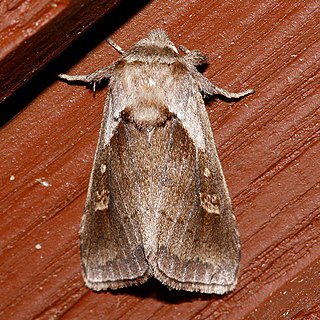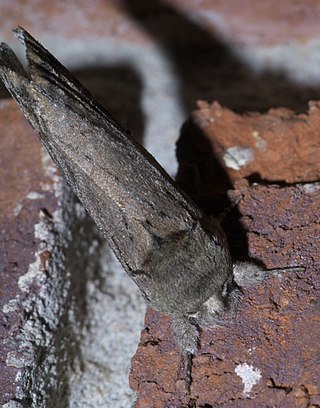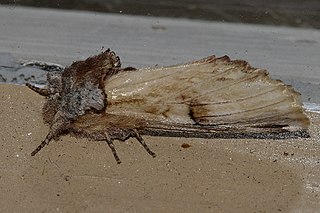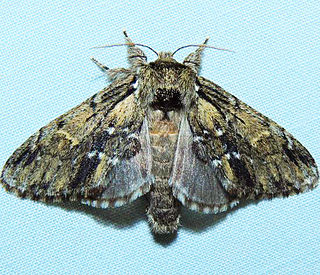Dasylophia seriata, the western legume prominent, is a species of moth in the family Notodontidae. It was first described by Druce in 1887 and it is found in North America.

Heterocampa astarte, the astarte prominent moth, is a species of moth in the family Notodontidae. It was first described by Edward Doubleday in 1841 and it is found in North America.

Bellura obliqua, the cattail borer, is a species of cutworm or dart moth in the family Noctuidae. It was first described by Francis Walker in 1865 and it is found in North America.
Heterocampa secessionis is a species of moth in the family Notodontidae. It was first described by Foster Hendrickson Benjamin in 1932 and it is found in North America.
Heterocampa ruficornis is a species of moth in the family Notodontidae. It was first described by Harrison Gray Dyar Jr. in 1905 and it is found in North America.
Heterocampa benitensis, the spring snowflake, is a species of moth in the family Notodontidae. It was first described by André Blanchard in 1971 and it is found in North America.
Hyparpax aurostriata is a species of moth in the family Notodontidae. It was first described by Graef in 1888 and it is found in North America.
Heterocampa amanda is a species of moth in the family Notodontidae. It was first described by William Barnes and Arthur Ward Lindsey in 1921 and it is found in North America.
Notodonta pacifica is a species of moth in the family Notodontidae. It was first described by Hans Hermann Behr in 1892 and it is found in North America.

Peridea basitriens, the oval-based prominent, is a species of moth in the family Notodontidae. It was first described by Francis Walker in 1855 and it is found in North America.

Cecrita lunata is a species of moth in the family Notodontidae. It was first described by Henry Edwards in 1884 and it is found in the western United States and Mexico.
Rifargia bichorda, or Hampson's prominent moth, is a species of moth in the family Notodontidae. It was first described by George Hampson in 1901 and it is found in North America.
Notodonta scitipennis, the finned-willow prominent or base-streaked prominent, is a species of moth in the family Notodontidae. It was first described by Francis Walker in 1862 and it is found in North America.
Heterocampa varia, the sandplain heterocampa, is a species of moth in the family Notodontidae. Other common names include the alpine mouse-ear and white-marked heterocampa. It was first described by Francis Walker in 1855 and it is found in North America.

Heterocampa biundata, the wavy-lined heterocampa, is a species of moth in the family Notodontidae. It was first described by Francis Walker in 1855 and it is found in North America.
Heterocampa zayasi, the blue moor-grass moth or zaya heterocampa, is a species of moth in the family Notodontidae. It was first described by Torre and Alayo in 1959 and it is found in Cuba.

Oedemasia leptinoides, the black-blotched schizura or black-blotched prominent, is a species of moth in the family Notodontidae. It was first described by Augustus Radcliffe Grote in 1864 and is found in North America.

Oligocentria pallida, the pale prominent, is a species of moth in the family Notodontidae. It was first described by Strecker in 1899 and it is found in North America.
Lacinipolia aileenae is a moth genus or species of cutworm or dart moth in the family Noctuidae. It is found in North America.

Hyperaeschra georgica, the Georgian prominent, is a species of moth in the family Notodontidae. It was first described by Gottlieb August Wilhelm Herrich-Schäffer in 1855 and it is found in North America and parts of Australia.








